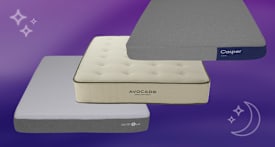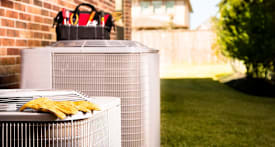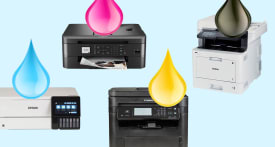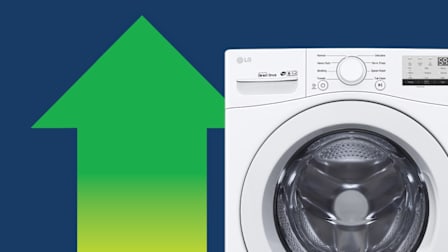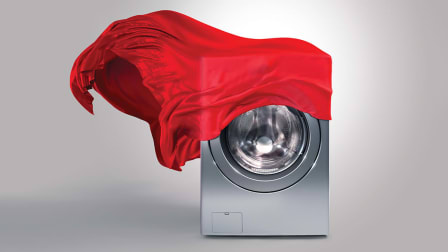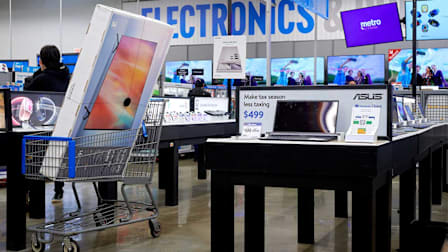Should You Buy a Used Appliance?
Buying used appliances means you could get a great stove, refrigerator, washer, or dryer for a fraction of the price. Is it worth it?
With the looming threat of tariffs, there’s every reason to believe prices for new appliances could soon shoot up. (According to an estimate from the Budget Lab at Yale, a nonpartisan policy research center, the tariffs could cost the average household something like $3,800 more a year for new goods and components.) Buying a used appliance is one way to save over buying new. There are some pretty significant environmental benefits to shopping secondhand, too.
Nearly 137 billion pounds of e-waste—discarded electronics with a battery or plug—were generated globally in 2022, according to a November 2024 report from the United Nations Global E-waste Monitor. Large appliances make up about a quarter of that waste. The amount of e-waste continues to grow every year and is predicted to increase to 181 billion pounds by 2030, making it the world’s fastest-growing domestic waste stream.
- Where to Shop for Used Appliances
- What to Expect With Used Appliances: Selection Life Expectancy Price Delivery and Installation
- Shopping Checklist
Where to Shop for Used Appliances
There are several ways to get a quality used appliance, but we recommend buying from a used appliance store or local repair shop instead of places like Craigslist, Facebook Marketplace, and yard sales.
According to the appliance experts we interviewed, prices tend to be lower at used appliance stores and local repair shops. But the main selling point of those retailers is the warranty. We called a dozen shops across the U.S. and found that warranty coverage ranges from six weeks to six months, including parts and labor. But regardless of its length, any warranty guarantees you’ll at least go home with an appliance that works.
Many repair shops have technicians inspect appliances and replace any worn-out parts before selling them. They can probably tell you more about the machine’s condition than the average consumer who’s selling a used appliance.
You might also consider thrift stores or nonprofits. Yoselin Genao-Estrella, executive director at Neighborhood Housing Services of Queens, says she saved more than $6,000 and stayed well within her budget by shopping for kitchen appliances at the Habitat for Humanity NYC ReStore in Queens, N.Y. “I ended up getting my dream Viking stove plus a GE Profile refrigerator for $1,000,” she says.
Thrift store prices can be comparable to those at used appliance stores, but keep in mind that those sellers aren’t appliance experts, and inspections may not go beyond plugging in the appliance to make sure it turns on. But some places, such as Habitat for Humanity ReStore, offer a 30-day guarantee that the appliance will work or they’ll give you store credit. Plus, when ReStore affiliates across the U.S. sell used appliances, proceeds go toward building and preserving low-income housing.
What to Expect When Shopping for a Used Appliance
Selection
Many used appliance stores sell ranges, washers, dryers, and refrigerators. They don’t often sell dishwashers or microwaves because the prices of those appliances are already so low that shop owners won’t make money on them. You won’t find many wall ovens, cooktops, or built-in refrigerators, either, because they can require different-sized cutouts in a wall or countertop, so they appeal to fewer shoppers.
According to the sellers we interviewed, most of the used appliances you’ll find will be under 10 years old, though some may go back as far as 15 years. (You’ll want to pass on most of those. You’ll see more about why in the section about life expectancy.) And don’t expect to see many of the latest features.
“Used appliance selections are typically behind on trends,” says Dan Leonardi, owner of Leonardi Appliance Parts & Service just outside of Chicago. “So right now you’re going to see side-by-side refrigerators and top-load washers. There’s a lot of white and black appliances in used appliance inventory.”
Depending on the size of the store, there could be 30 to 40 pre-owned appliances at any given time, compared with over 100 new models at big-box stores. That may seem like slim pickings, but the inventory can change from day to day; you just have to keep checking. Genao-Estrella visited ReStore at least a dozen times before she found the range she wanted.
Life Expectancy
Appliance repair technicians don’t usually bother with models that are more than 15 to 20 years old because they’re probably not worth the cost of repair. “You’re unlikely to get much more use out of these dinosaurs,” Leonardi says. “We want to make sure customers will still get an average of seven years out of them.”
How long will the appliance you’re shopping for last? That depends on the specific machine, but here are some general estimates to keep in mind from the Association of Home Appliance Manufacturers (AHAM), a trade organization:
- Electric range: 13-15 years
- Gas range: 15-17 years
- Refrigerator: 9-13 years
- Dryer: 13 years
- Washing machine: 5-15 years
“You want to know the age of an appliance because it’ll allow you to balance the useful life of an appliance with its price,” says Jill Notini, vice president of communications at AHAM. “If you’re spending $200 on a 10-year-old refrigerator with an average life of 12 years, you have to be aware and ask yourself if it’s worth it.”
In Genao-Estrella’s case, the trade-off made sense. “I did the math, and based on how much I was saving, the investment will be good for two to three years,” she said. “Obviously, I hope it’ll last for much longer than that, but you have to have realistic expectations. It’s not for everybody.”
In April 2025, nearly five years after we first interviewed her, Genao-Estrella tells us that the lifespan of her used appliances has far exceeded her expectations. “We anticipated needing replacements in five years, but here we are, in year seven, and they’re still working perfectly,” she says.
To know what to expect, check out CR’s list of the most common appliance problems and repairs, which outlines the appliance parts that fail most often. For instance, built-in icemakers are a common problem in refrigerators, so if you’re looking at a model with one, make sure it’s working. And mold can be a problem for a number of front-load washers. Always sniff for funky smells and peel back the rubber door gasket to check for mold underneath it. Another common problem with washers is the door or lid switches. If they don’t latch properly, the drum won’t spin.
Data from our major appliance surveys can help you weigh the risks of a particular used appliance by looking at brand reliability. (We survey tens of thousands of CR members, who report whether problems cropped up within the first five years of owning their new appliances.) See which brands rank best and worst for reliability in refrigerators, gas ranges, electric ranges, pro-style ranges, washing machines, and dryers.
When it comes to an appliance’s life expectancy, there are exceptions to the rule. For instance, some of the repair technicians we spoke with mentioned that the Whirlpool direct-drive washing machine is a shining example of a true workhorse. Those top-load washers were built in the 1990s under various brand names, including Maytag, Kenmore, and Roper.
“I can sell that 25-year-old machine for $275 because it was built like a tank and lasts,” Leonardi says. “Once we rebuild them with new parts, you can get another 10 or 15 years out of them.”
Price
Older pre-owned appliances can be as much as 75 percent off the original retail price before factoring in any delivery and installation fees (see more on that below). But on average, you can expect about 50 percent off—even if the appliance hasn’t actually been used at all.
“It’s amazing how many brand-new kitchen appliances we get,” says Leslie Williams, director of the ReStore in New York. “When people purchase a home, they never want the kitchen that’s in it. They want their own custom kitchen, even though what’s there are great, brand-new pieces.”
Delivery and Installation
Remember to include delivery and installation costs in your budget for a used appliance. These fees may end up costing more than the appliance itself, in which case buying a new one from a store that includes these services may be a better option.
Some used appliance stores require you to arrange your own pickup and delivery. Some offer delivery that includes hauling away your existing appliance. From our research, delivery costs range from $25 to $200. Delivery services often work only locally, so unless you have your own truck or plan to rent one, shop close to home.
One piece of advice regarding transporting refrigerators from CR’s Minkin: If it can fit in your truck standing up, it’s best to transport the refrigerator that way so you don’t have to worry about the lubricants migrating away from the compressor. If the refrigerator must be laid down for transportation, only do so on the left or right side (this should be specified by the manufacturer in the product’s Use and Care guide), and be sure to let it stand upright in your kitchen for at least 24 hours before plugging it in to allow time for the oil to flow back into the compressor. If you don’t, you risk breaking the compressor by running it without this essential lubricant.
Some appliances just need to be plugged in for installation, but others require more work. “If you don’t know how to hook up gas lines on ranges and dryers or connect a dryer vent, consider hiring an appliance repair professional to do it for you,” Minkin says.
According to HomeAdvisor, you can expect to pay $105 to $125 to install a range and $50 to $175 to install a washing machine if you have all the energy and plumbing lines installed and proper venting in place.
Used Appliance Shopping Checklist
Below, we’ve compiled a shopping checklist to use as you begin your journey to successfully purchasing a reliable used appliance.
Research the appliance you want. Have an idea of what features you want before you go shopping. Do you prefer a top-load washer or front-loader? Does it matter whether your fridge’s freezer is on the top or the bottom? Are you desperate for a convection oven? Is it stainless steel or bust? If you’re not sure where to start, check out CR’s buying guides for washers, dryers, refrigerators, and ranges for more info on all types of these appliances.
If what you’re looking for is harder to find—like that convection oven—ask salespeople or repair technicians to keep an eye out for you and call you if they get one in. And know which type of fuel source you have so that you don’t waste time, say, browsing electric ranges if you have gas-line connections.
You can also check out CR’s reliability ratings on brands that last for a frame of reference on your better bets. Our brand reliability rankings cover appliances from more than two dozen brands purchased new between 2014 and 2024. You can also do a model search on our website for ratings and reviews; many older appliances can still be found there. And look up which models have readily available replacement parts on repairclinic.com so that if your machine breaks, it’ll be easy to get spare parts.
Once you have a contender, find the manufacturer’s sticker, usually on the doorjamb or other inconspicuous area of the appliance. Jot down the serial number and model number. Use that to check whether it has been included in a safety recall. If the machine doesn’t have a model number and serial sticker in place, avoid it. It could have been recalled or scrapped and illegally salvaged.
You’ll also want to look for the date of manufacture stamped on the appliance’s sticker. If it’s not on the sticker, use the serial number to look it up online. Refer to the AHAM average useful life guidelines, above, to figure out how many working years your appliance is likely to have left.
One other research note: Used appliances seldom come with manuals, but manufacturers typically make them available on their websites. You can search for the model number to download the manual for your appliance.
Check a shop’s reviews. Scour Yelp and the Better Business Bureau website for red flags about stores you’re interested in, like problems with their warranties or installation. “Consumers should read reviews and make sure they’re buying from a company that will honor its warranties,” Leonardi says.
A note on warranties: Be sure to read them. A shop should give you a physical copy that’s explicit about what is and isn’t covered. Warranties should be free and cover reimbursement or replacement if the appliance dies under warranty.
Ask questions. “Similar to how you would ask about the repair service records of a used car, you want to ask what has been replaced on the appliance and what has been serviced in the past,” Notini says. If you’re at a shop, ask:
• What did you check for in your inspection of the appliance?
• Did you replace any parts? If so, did you use scrapped or new parts? (New is preferable.) Were the parts original equipment by the manufacturer (OEM) or generic (which are less than ideal)?
For instance, Leonardi Appliance installs new parts that are known to break even if they’re still working. “As technicians in the field with thousands of service calls under the belt, we know the high-failure problems with many models, so we’ll go after those common issues,” Leonardi says. “For instance, every gas dryer will get a new ignitor, coils on the gas valves, belts, rollers, and a fresh gasket.”
Other appliance store owners we spoke to told us they inspect every appliance before it hits the showroom floor. This includes testing temperatures for washing machines and refrigerators, checking motor speeds and switches, and inspecting for worn valve threads, agitator dogs, and leaking pump hoses. Those are crucial parts that you probably won’t check yourself, but it should be easy enough for the salesperson to tell you what was found.
Even if you don’t understand what all the parts do, asking questions gives you a sense of how much attention the seller gave the appliance. You can also ask whether their technicians are certified to service a specific brand you’re interested in.
Test the machine. Ask to plug it in, then:
• Check doors, knobs, and switches, whether they’re for lights or circulation fans.
• Look for any rust or damage. Some damage may be just cosmetic, like scratches and dents, but a frayed or damaged cord or cracked glass-top stove are safety issues that make the machine a no-go.
• Do a sniff test for musty, moldy smells that could indicate water damage.
• Make sure the appliance sits level.
• Look at the manual to make sure all the appliance’s pieces are there. You can do an online search for it right on your phone to see the model’s removable parts, such as shelves, drawers, and racks, that should come with the specific range or refrigerator.
Negotiate. Haggling is entirely acceptable and even expected. You may have more room to bargain if you pay in cash, buy more than one item, or take the appliance home immediately. “I would give a customer 10 percent off if they took it off my showroom floor right away,” Williams says.
Which Brands Make the Most Reliable Appliances?
CR members can access our appliance brand reliability rankings to see how reliable one brand is relative to another (scroll to the bottom of the article for an interactive chart). The results are based on data CR collected from our members on more than 375,000 major kitchen and laundry appliances purchased between 2014 and 2024.
CR’s rankings show how reliable a brand is relative to others across multiple appliance types: refrigerators, dishwashers, over-the-range microwaves, ranges, cooktops, wall ovens, washing machines, and dryers. While it may not cover all the appliances you’ll see out there, it will at least help guide you toward the best brands to buy and help you avoid problem-prone machines.
Because you’re probably not purchasing a suite of appliances, focus on how the brands score for the particular type of appliance you’re shopping for rather than the brand’s Overall Score. Bosch, for example, rates excellent in reliability for dishwashers but less so for washers and dryers.
Keep in mind there are always exceptions. For instance, Viking ranges rate poor for reliability based on our members’ feedback, yet Genao-Estrella has had no problems after five years of use. "The stove is fine, and since we’ve been working from home, we’re cooking more than ever," she says. But the GE Profile fridge, which is rated very good for reliability, needed a compressor repair, which cost $400.
Any regrets? “Not at all,” Genao-Estrella says. “We’ve had brand-new fridges that completely broke after two years, too. You just never know with appliances."




